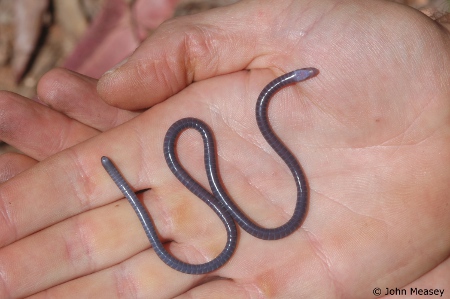As explained in this blog post from 2011 chytrid fungus (Batrachochytrium dendrobatidis) is one of the primary reasons that amphibians face the greatest risk of imminent extinction. Recent research has found that the third and final major group of amphibians, caecilians, have also been infected by the deadly disease.
Amphibians are currently facing the worst extinction risk of all the animals groups. According to the IUCN red list 41% of amphibians are currently threatened (classified as either critically endangered, endangered or threatened). Whilst amphibians are subject to a number of threats, including habitat loss or degradation, climate change and exploitation, one of most concerning is chytrid fungus. This skin parasite has been found across the globe and is considered a major contributor to the global amphibian crisis. A recent study has found the fungus in the third and final group of amphibians.
There are approximately 7,000 amphibian species which can be split into three main groups; frogs and toads, newts and salamanders and caecilians. The first two orders are more numerous and common than the limbless soil-dwelling caecilians and hence are better understood and studied. Chytrid fungus was first discovered in 1998 and has since been found in hundreds of amphibian species over all continents. It has long been suspected that caecilians are susceptible to chytrid fungus, due to biological similarities; however this had not been proven. This is primarily because they are not routinely encountered by normal amphibian field surveys.
A recent study published in EcoHealth set out to establish whether caecilians are vulnerable to chytrid fungus. The study looked at wild caught and pet caecilians from five countries has shown that caecilians are susceptible to chytrid fungus. Approximately 30% of the caecilians in the study tested positive for chytrid fungus. Interestingly the individuals taken from South America were not found to have chytrid fungus even though it has been found on other amphibians in the region.
Whilst the fact that caecilians are susceptible to chytrid fungus does not come as a great surprise it is still concerning due to the impact it has on amphibian populations. Two thirds of caecilian species are listed as data deficient because of a lack of information. Whilst we now know they are threatened by chytrid fungus we still lack understanding of their ecology and how best to conserve them.
The top 100 EDGE amphibians features two caecilians (number 3 Sagalla caecilian and number 54 Cooper’s black caecilian) whilst the list of ten potential EDGE species is made up entirely of caecilians. This highlights the importance of caecilian conservation but this cannot be implemented until we have a better understanding of their ecology, threats and status.
EDGE fellow Marcel Talla Kouete is based in Cameroon where he is carrying out research on a number of caecilian species. He is helping to assess and classify five data deficient species as well as raising awareness in local communities and improving the capacity for local amphibian conservation.
To find out more about Marcel and his work in Cameroon visit his community page or watch his video blog
